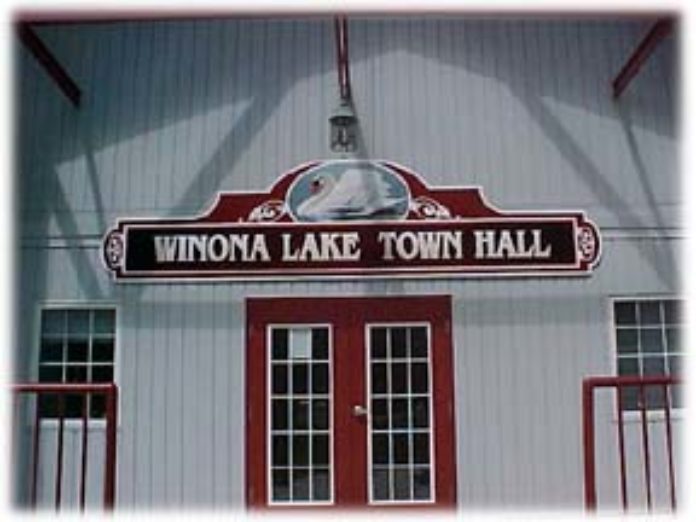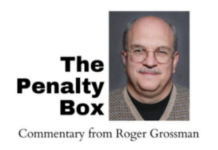The Winona Lake Town Council Tuesday held a public hearing for the town’s proposed stormwater utility that would charge property owners $9 per unit by 2023.
Mary Atkins, vice president at Wessler Engineering, and Deen Rogers, with Baker Tilly, presented residents with information before questions were fielded. Wessler Engineering was hired by the town to conduct a rate study in October, and Baker Tilly is assisting the town with the financials of the proposed utility.
Atkins said stormwater runoff in Winona Lake flows to three different watersheds, which are Winona Lake, Pike Lake and the Wyland Ditch. Stormwater picks up pollutants and carries them to waterways, and once that pollution reaches those waterways it can poison fish, damage ecosystems and even flow to water used for drinking or recreation. Atkins noted that Winona Lake is primarily used for recreation.
She further explained that a stormwater utility is a utility that provides management of the stormwater, generates revenue by charging user fees, with residents being assessed a common rate of 1 ERU (Equivalent Residential Unit) and nonresidential properties are charged according to impervious surface measurement.
The utility is governed by the town council. The management needs would be maintenance of the existing storm system that includes underground pipes, inlets, ditches and so forth. The revenue from the utility would also help fund manpower, labor, equipment, materials and administrative costs, as well as fixing failing and deteriorating stormwater infrastructure. The revenue generated would help the town prioritize projects.
Town Manager Craig Allebach pointed to the town’s several projects on his list that need fixed because areas flood, including two major projects at Boys City Drive and Court Circle. However, those expensive projects are just a few areas in the town that need attention when it comes to stormwater drainage problems. Allebach noted that some homeowners don’t want to make home improvements until the stormwater problem is fixed. That takes money and time, Allebach said.
This proposed utility would be phased in over three years. Based on Wessler’s and Baker Tilly’s study, the rate for Winona Lake should be $9 per unit. The town, however, has chosen to phase in that cost to owners, starting with $5 in 2021; $7 in 2022; and then up to the $9 by 2023. The Town Council will vote on the matter at its next meeting at 6 p.m. Dec. 15.
Rogers produced a bar graph that compares area cities and towns and the rates that are charged there. By 2025, for example, the stormwater utility rate in Warsaw will be $8, with Columbia City currently charging $9.15 per unit.
Resident Jerry Nelson reminded the council he owns several rental properties in town and has lived here for more than 20 years.
“I live on the lake, I have a sump pump and pump my water directly to the lake,” Nelson said. “Will that get me a credit so I don’t have to pay on that particular facility for stormwater because I don’t generate any? … The property on Court Circle they’re talking about is a project right behind me, and those people pump their stormwater right out into the alley, so should they get away with saying, ‘Well, look, I can dispose of mine there and you can deal with it,’ or should they have some responsibility to pay for the situation?”
Nelson said he thinks the council should look at the stormwater budget each year and evaluate it before setting a rate out three years and saying “this is what we’d like to have.” Nelson said he doesn’t think the amount of revenue the town will generate from the utility will in fact help fund the lengthy list of projects.
“Seems like the town of Winona Lake always comes up with another fee-based service, and I get to pass that along to my renters,” Nelson said.
Allebach said the council will review the stormwater budget yearly, and, by the way, the town isn’t required by law to even have a stormwater budget but they believe it’s for the betterment of the citizens to lay that out.
Nelson suggested the council instead take money out of the rainy day fund.
“Jerry, the rainy day fund is for a rainy day,” Allebach said. “We don’t know what’s going to happen (with COVID). We have to keep that there, because we have reduced taxes and reduced revenue from motor vehicle funds, so how are we gonna support our budget? Next year won’t be too bad, but 2022, we don’t know what will happen.”
Rogers said $150,000 is projected to be generated in the first year at the $5 rate; $210,000 at the $7 rate; and $270,000 at the $9 rate.
“The $9 rate is justified now,” Rogers said. “We’re just phasing in that rate.”
Dr. Nate Bosch, director of the Lilly Center for Lakes & Streams, asked if residents can expect to see a real difference if this utility is passed when it comes to better drainage and less pollution.
Allebach said he doesn’t think people will immediately see a major shift but the town will, primarily early on target flooding projects and projects where there’s been problems. However, Allebach noted that the town has partnered with Lakes & Streams and The Watershed Foundation and gave more than $17,000 to have them clean up around Cherry Creek and the run-off problem there. That project was a $170,000 project, he said. He also said that, for example, about two years ago the town street crew would mow right down to the water’s edge of the creek and it wasn’t until they were told by people like Bosch to leave a little buffer and not blow the clippings into the creek that they adjusted the way the crews did things.
“So we do appreciate the work you do and those kinds of things we maybe don’t understand until you explain this is the reason why,” Allebach said, reassuring that the town will be accountable for making things better if the utility is passed.
Atkins also reminded residents to not think of the water that’s on or not on their property but rather about the water on the town. “It’s a community benefit, because everyone drives on the flooded streets,” she said.
Council President Rick Swaim reiterated, “It truly is a community benefit.”





